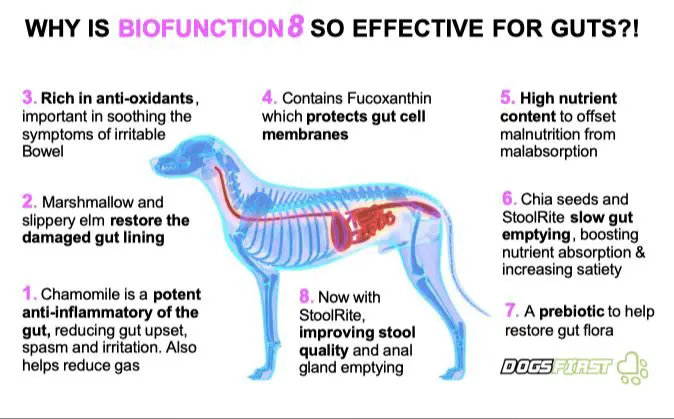Introduction
High protein dog food is dog food that contains much higher levels of protein than traditional dog food. While traditional dog food contains around 18-24% protein, high protein dog foods can contain anywhere from 30-70% protein.
High protein dog food has become a popular choice for many dog owners in recent years. Proponents claim that the high protein content helps build lean muscle mass, boosts energy levels, and aids in weight loss. However, others argue that too much protein can put unnecessary strain on a dog’s kidneys and liver.
So is high protein dog food safe and healthy for dogs? Or is it too much of a good thing? There is an ongoing debate around the pros and cons of high protein dog diets, which we’ll explore in this article.
Pros of High Protein Dog Food
One of the biggest benefits of high protein dog food is that it can help build muscle, especially in active dogs. Protein is essential for muscle growth and repair. Dogs with high exercise needs, like working dogs or dogs that participate in canine sports, require more protein in their diet to maintain their muscle mass and energy levels. High protein foods provide the amino acids dogs need to preserve existing muscle tissue and build new muscle.
Active and working dogs have higher protein demands. Without adequate protein intake, they may start burning muscle for fuel instead of fat or carbohydrates during exercise. This can lead to muscle wasting and fatigue. High protein foods supply the nutrients these dogs require to stay strong, energetic and prevent muscle loss.
Cons of High Protein Dog Food

While high protein dog food does have its benefits, there are some potential downsides to feeding your dog a diet very high in protein that should be considered.
One of the main concerns with excessive dietary protein is the strain it can put on your dog’s kidneys. The kidneys are responsible for metabolizing protein and eliminating the waste products through the urine. When dogs ingest very high amounts of protein for prolonged periods, it forces the kidneys to work harder to filter out the protein byproducts.
Over time, this can put stress on the kidneys and potentially lead to kidney damage or disease later in life. Older dogs may be at higher risk for this issue, as kidney function tends to decline naturally with age. Dogs with existing kidney problems also need to be careful with high protein intake.
Therefore, while protein is essential, too much can be taxing on your dog’s system. Moderation is key when it comes to protein in your dog’s diet. Consult with your veterinarian about an appropriate level of protein for your individual dog based on their age, health status, and specific needs.
How Much Protein Do Dogs Need?
The amount of protein a dog needs depends on the dog’s life stage (puppy, adult, senior) and activity level. Puppies generally need higher amounts of protein to support growth and development. Adult dogs need protein for maintenance of muscle mass and organ function, but senior dogs may need reduced protein due to decreased activity levels.
According to the National Research Council, the minimum dietary protein requirements for dogs are:
- Puppies: 22% of total calories
- Adult dogs: 18% of total calories
- Senior/less active dogs: 15% of total calories
Higher protein needs apply for active, working, or sporting dogs that use protein to build and maintain more muscle mass. Some sources recommend over 30% protein for highly active dogs. Consult your veterinarian for the ideal protein target based on your dog’s specific condition and lifestyle.
Signs Your Dog is Eating Too Much Protein

While protein is an essential part of your dog’s diet, too much can lead to health issues. Here are some signs your dog may be getting more protein than needed:
- Increased thirst and urination – A diet too high in protein puts extra strain on your dog’s kidneys as they work to filter out the excess protein breakdown products. Your dog may drink more water and urinate more frequently as their kidneys try to keep up.
- Weight loss – Since protein contains fewer calories per gram than fat or carbohydrates, a very high protein diet can cause weight loss as your dog’s body breaks down its fat and muscle stores to compensate for the calorie deficit.
If your dog is displaying these signs on a high protein diet, consider switching to a food with a more moderate or balanced protein content. Always consult your veterinarian if you have concerns about your dog’s nutrition and health.
Best Sources of Protein for Dogs
Some of the best sources of high-quality protein for dogs include:
Whole Meats: Meat contains all the essential amino acids dogs need. Muscle meat from chicken, beef, turkey, lamb etc. are excellent sources of protein. Organ meats like liver are also packed with nutrients.
Eggs: Eggs are an affordable protein source that are loaded with vitamins and minerals. The whites contain quality lean protein, while the yolks provide healthy fats.
Dairy: Milk proteins like casein and whey are readily digested and absorbed. Non-fat Greek yogurt and cottage cheese are excellent options.
When choosing a protein source, lean whole meats, eggs, and dairy products provide the best nutritional profile for dogs. Look for a named meat or meat meal as the first ingredient when selecting a high protein dog food.
Tips for Choosing a High Protein Dog Food
When considering a high protein dog food, there are some tips to keep in mind:
Get your vet’s opinion. Consult with your veterinarian before switching your dog to a high protein food. They can evaluate your dog’s specific nutritional needs based on their age, breed, activity level, and health status.
Pick high-quality protein sources. Look for whole, natural protein sources like chicken, beef, fish, eggs, etc. Avoid fillers, by-products, and artificial preservatives.
Transition slowly. Gradually transition your dog to a high protein food over 5-7 days. Start by mixing a small amount of the new food with their current food, slowly increasing the ratio of new to old.
Monitor your dog’s reaction. As you transition foods, watch for signs of gastrointestinal upset or other adverse reactions. Slow the transition if needed.
Provide plenty of water. Make sure your dog has constant access to fresh water to stay hydrated on a high protein diet.
High Protein Recipes for Homemade Dog Food

If you want to make your own high protein dog food at home, here are some nutritious recipes to try:
Beef and Sweet Potato Dog Food
Ingredients:
- 1 lb ground beef (90% lean)
- 2 sweet potatoes, peeled and diced
- 1 cup green beans, chopped
- 2 carrots, peeled and shredded
- 2 tablespoons olive oil
Instructions:
- In a skillet over medium heat, cook ground beef until browned and crumbled. Drain excess fat.
- Fill a pot with water and bring to a boil. Add sweet potatoes and cook 5-7 minutes until soft. Drain and set aside.
- In a pan over medium heat, sauté green beans and carrots in olive oil for 4-5 minutes until tender.
- In a large bowl, mix together ground beef, sweet potatoes, green beans and carrots. Portion into individual containers and store in the refrigerator for up to 5 days.
Salmon and Brown Rice
Ingredients:
- 1 lb salmon fillet, skinned and cut into cubes
- 1 cup brown rice
- 2 eggs
- 1 cup peas
- 2 tablespoons vegetable oil
Instructions:
- In a pot, bring water to a boil and cook brown rice according to package directions.
- In a non-stick skillet, cook salmon over medium heat for 4-5 minutes until opaque and flaky.
- In a small bowl, whisk together eggs. Scramble the eggs in a skillet until fully cooked.
- In another skillet, sauté peas in vegetable oil for 2-3 minutes.
- In a large bowl, mix together cooked rice, salmon, eggs and peas. Portion into individual containers and refrigerate for up to 4 days.
Conclusion: The Verdict on High Protein Dog Food
When fed appropriately and from quality sources, high protein dog food does have some notable benefits. The high protein content can help maintain lean muscle mass, boost metabolism, and provide lasting energy. Many active, working, and athletic dogs do well on higher protein intakes.
However, excess dietary protein carries risks too. It can put unnecessary strain on the kidneys and liver, lead to weight gain, and cause GI issues. Moderation is key when feeding protein to dogs. Each individual dog has an optimal protein requirement based on their age, breed, size, activity level and other factors.
Pet owners should aim to find a high quality protein source and feed their dog the minimal amount needed to maintain good health and condition. Monitoring portion sizes, calories, and their dog’s body condition will help determine appropriate protein intake. Consulting with a veterinarian will also provide useful guidance.

When sourcing protein for dogs, lean meats, eggs, dairy and legumes tend to be the best options. Proteins derived from plants vs animals have differences in digestibility and amino acid balance to consider as well. As long as basic nutritional requirements are met and excesses avoided, both plant and animal proteins can successfully fuel dogs.
With mindful selection and feeding practices, a high protein diet can be safe and beneficial for many dogs. Pet owners simply need to ensure their dog tolerates the protein well and thrives on the higher intake. Finding the optimal protein level provides dogs with the nourishment they need for good health.
References
FDA. “Selecting Nutritious Pet Foods.” FDA, www.fda.gov/animal-veterinary/animal-health-literacy/selecting-nutritious-pet-foods. Accessed 15 Feb. 2023.
Case, Linda P., et al. “Canine and Feline Nutrition-E-Book: A Resource for Companion Animal Professionals.” Elsevier Health Sciences, 2021.
Wakshlag, Joseph J., et al. “Dietary Protein and Renal Functions of Healthy Dogs: A Meta-Analysis.” Journal of Veterinary Internal Medicine, vol. 32, no. 2, Mar. 2018, pp. 652–662. Wiley Online Library, https://doi.org/10.1111/jvim.15056.
Laflamme, Dorothy. “Development and Validation of a Body Condition Score System for Dogs.” Canine Practice, vol. 22, no. 4, July 1997, pp. 10–15.
Fascetti, Andrea J., and Sean J. Delaney. “Applied Veterinary Clinical Nutrition.” Wiley Blackwell, 2012.